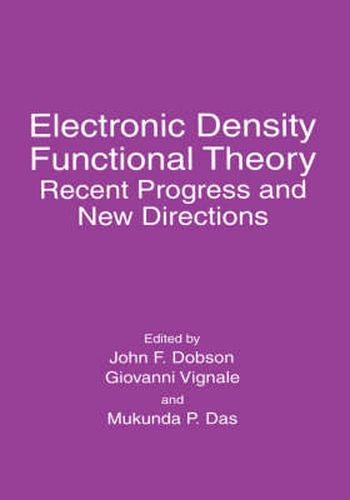Readings Newsletter
Become a Readings Member to make your shopping experience even easier.
Sign in or sign up for free!
You’re not far away from qualifying for FREE standard shipping within Australia
You’ve qualified for FREE standard shipping within Australia
The cart is loading…






This title is printed to order. This book may have been self-published. If so, we cannot guarantee the quality of the content. In the main most books will have gone through the editing process however some may not. We therefore suggest that you be aware of this before ordering this book. If in doubt check either the author or publisher’s details as we are unable to accept any returns unless they are faulty. Please contact us if you have any questions.
This book is an outcome of the International Workshop on Electronic Density Functional Theory, held at Griffith University in Brisbane, Australia, in July 1996. Density functional theory, standing as it does at the boundary between the disciplines of physics, chemistry, and materials science, is a great mixer. Invited experts from North America, Europe, and Australia mingled with students from several disciplines, rapidly taking up the informal style for which Australia is famous. A list of participants is given at the end of the book. Density functional theory (DFT) is a subtle approach to the very difficult problem of predicting the behavior of many interacting particles. A major application is the study of many-electron systems. This was the workshop theme, embracing inter alia computational chemistry and condensed matter physics. DFT circumvents the more conceptually straightforward (but more computationally intensive) approach in which one solves the many-body Schrodinger equation. It relies instead on rather delicate considerations involving the electron number density. For many years the pioneering work of Kohn and Sham (the Local Density Ap proximation of 1965 and immediate extensions) represented the state of the art in DFT. This approach was widely used for its appealing simplicity and computability, but gave rather modest accuracy. In the last few years there has been a renaissance of interest, quite largely due to the remarkable success of the new generation of gradient functionals whose initiators include invitees to the workshop (Perdew, Parr, Yang).
$9.00 standard shipping within Australia
FREE standard shipping within Australia for orders over $100.00
Express & International shipping calculated at checkout
This title is printed to order. This book may have been self-published. If so, we cannot guarantee the quality of the content. In the main most books will have gone through the editing process however some may not. We therefore suggest that you be aware of this before ordering this book. If in doubt check either the author or publisher’s details as we are unable to accept any returns unless they are faulty. Please contact us if you have any questions.
This book is an outcome of the International Workshop on Electronic Density Functional Theory, held at Griffith University in Brisbane, Australia, in July 1996. Density functional theory, standing as it does at the boundary between the disciplines of physics, chemistry, and materials science, is a great mixer. Invited experts from North America, Europe, and Australia mingled with students from several disciplines, rapidly taking up the informal style for which Australia is famous. A list of participants is given at the end of the book. Density functional theory (DFT) is a subtle approach to the very difficult problem of predicting the behavior of many interacting particles. A major application is the study of many-electron systems. This was the workshop theme, embracing inter alia computational chemistry and condensed matter physics. DFT circumvents the more conceptually straightforward (but more computationally intensive) approach in which one solves the many-body Schrodinger equation. It relies instead on rather delicate considerations involving the electron number density. For many years the pioneering work of Kohn and Sham (the Local Density Ap proximation of 1965 and immediate extensions) represented the state of the art in DFT. This approach was widely used for its appealing simplicity and computability, but gave rather modest accuracy. In the last few years there has been a renaissance of interest, quite largely due to the remarkable success of the new generation of gradient functionals whose initiators include invitees to the workshop (Perdew, Parr, Yang).